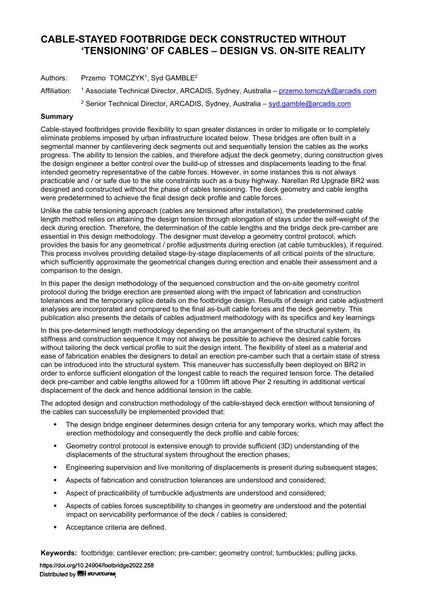Cable-Stayed Footbridge Deck Constructed Without Tensioning of Cables – Design vs. On-Site Reality

| Author(s): |
Przemo Tomczyk
(Associate Technical Director, ARCADIS, Sydney, Australia)
Syd Gamble (Senior Technical Director, ARCADIS, Sydney, Australia) |
|---|---|
| Medium: | conference paper |
| Language(s): | English |
| Conference: | Footbridge 2022: Creating Experience, Madrid, Spain, 07-09 September 2022 |
| Published in: | Footbridge Madrid 2022 - Creating Experience |
| DOI: | 10.24904/footbridge2022.258 |
| Abstract: |
Cable-stayed footbridges provide flexibility to span greater distances in order to mitigate or to completely eliminate problems imposed by urban infrastructure located below. These bridges are often built in a segmental manner by cantilevering deck segments out and sequentially tensioning the cables as the works progress. The ability to tension the cables, and therefore adjust the deck geometry, during construction gives the design engineer a better control over the build-up of stresses and displacements leading to the final intended geometry representative of the cable forces. However, in some instances this is not always practicable or safe due to the site constraints such as a busy highway. Narellan Rd Upgrade BR2 was designed and constructed without the phase of cable tensioning. The deck geometry and cable lengths were predetermined to achieve the final design deck profile and cable forces. In this paper the design methodology of the sequenced construction and the on-site geometry control protocol during the bridge erection are presented along with the impact of fabrication and construction tolerances and the impact of temporary splice details on the footbridge design. Results of design and cable adjustment analyses are incorporated and compared to the final as-built cable forces and the deck geometry. This publication also presents the details of cables adjustment methodology with its specifics and key learnings. |
| Keywords: |
footbridge cantilever erection geometry control pre-camber parametric excitation turnbuckles pulling jacks
|
| License: | This creative work is copyrighted. The copyright holder(s) do(es) not grant any usage rights other than viewing and downloading the work for personal use. Further copying or publication requires the permission of the copyright holder(s). |
Structures and Projects
0.08 MB Download full text file (PDF)
0.34 MB
- About this
data sheet - Reference-ID
10667399 - Published on:
30/05/2022 - Last updated on:
01/06/2022



